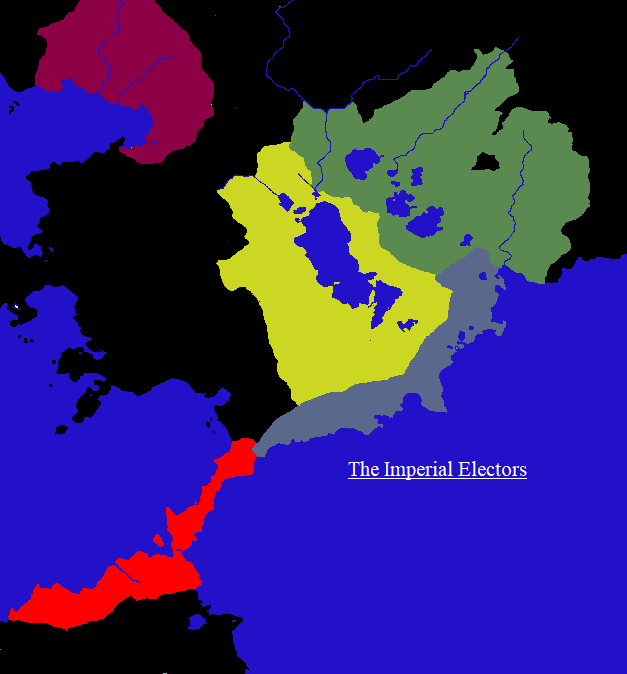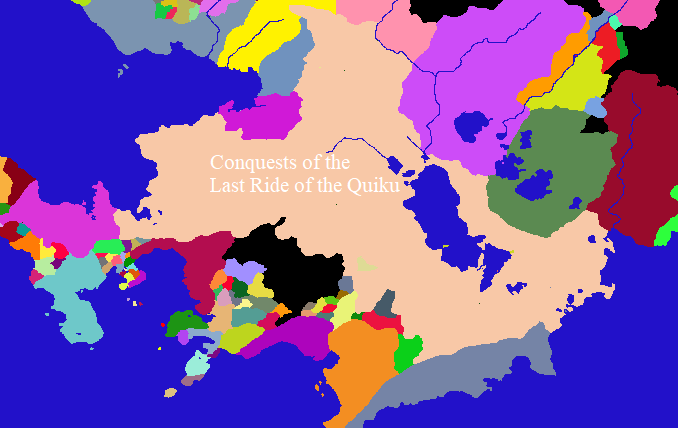Republic of Tuzek
Tuzek is the golden republic, the beating heart of the Suneka whose legalism and spartan obedience are to set an example for all other republics. This was once a land that arguably ruled the Suneka, whose troops carried its banner and whose rulers commanded trade and doctrine. Centuries of decline have tarnished that image and robbed Tuzek of much of its territory - but the republic of the great lake is rising again.
Beyond the propaganda and the geopolitics, Tuzek is a bountiful and prosperous land. Its massive lakes are covered in floating fields, its enormous cities bustle with traffic, and its great fortresses and military parades reflect a culture of farmers and merchants familiar with guns and blades. The culture here is one of obedience tempered with expectations of autonomy; restrained militarism bound to local needs. Those who follow the Suneka, work hard, and enjoy blunt conversation may find Tuzek to be one of the greatest Sunekan republics to live in. Those who aren't so comfortable with stern, sharp Suneka may find Tuzek to be unwelcoming, demanding, and hypocritical.
Structure
Tuzek is ruled by a centralized imperial government, with supreme power divided between the military Tlakra and the civilian Assembly.
- The Tlakra of Tuzek is elected for eight year terms, and acts as the supreme executive and top general. Running for office requires at least ten years of service as a military officer.
- The Supreme Congress, which is a legislature of 80 Imperial Speakers, organized by province. There are 14 provinces, with speakers distributed by population.
- Provincial Congress, 14 regional governments that manage local affairs.
- Prefects, military officers placed in charge of the provincial military bureaucracy
Culture
The Cult of Work
Tuzekan Cuisine
History
Early History (Divine Era)
Tuzek and the Rising Suneka (272 to 605)
Tuzek the Golden (605 to 1190)
Tuzek's Renewed Empire (1190 to 1721)
The Quiku Reckoning (1721 to 1870)
Modern History
Demography and Population
Around 18,000,000 humanoids live in the Republic of Tuzek. The population is roughly 35% Dryads, 30% Humans, 20% Hybrids, 10% Prisms, 5% Other. A vast multitude of cats live here.
Territories
Tuzek is 556 miles long and roughly 210 miles wide. At its heart is Lake Tuzeto - a massive lake roughly 350 miles long and 95 miles across famous for its rich black mud, giant fish, and thousands of tiny islands. Not all of Lake Tuzeto is controlled by Tuzek, currently, only the larger Northwestern part - including the vital straights of Silkepen, which are roughly 7 miles across and allow for easy control of lake traffic. Tuzek does claim the Southern half of the lake for its own, but has agreed to temporarily respect the states that currently control that half. There is a small Tuzekan enclave in the Northeastern corner of the Southern half, specifically the city of Ituken.
Two other large lakes sit Northwest of Tuzeto: Lake Dozsa, a 20x25 mile lake that connects with Tuzeto every rainy season; and Lake Artilet, which is 61 by 30 miles across and is fed by the 180-mile-long Tlamiko River.
Northern Tuzek is flatter and dotted with patches of grassland; Southern Tuzek is hillier and heavily forested.
Military
The military is a massive institution in Tuzek, a right of passage for those looking for a job not tied to the land (such as merchant work, ranching work, free labor, mercenary work, etc). Tuzekan mercenaries have become a staple of 1900's Sunekan militaries, and Tuzek encourages mercenaries to maintain military ties (to allow for Tuzek to draw them back into the military if needed).
Tuzek's cavalry is rivaled only by Zetepec within the Suneka. Horse archers, light cavalry, and heavy cavalry are all staples of Tuzek's martial approach, particularly their armored lancers. The Calazen invasion of the late 1800s also introduced Sudraco to the lake area, and Tuzek has so far been the only major Sunekan power to capture and domesticate them rather than kill them off. While there haven't been many chances for Tuzek to test their crocodile cavalry on the field, they have performed wonderfully the few times they have been deployed.
Backing up this cavalry are musketeers, archers, and spear levies. Interior Tuzek has a long history of fighting off mounted opponents with spears and arrows, and the current iteration is a more focused and disciplined version of that. Perhaps the greatest innovation have been firing drills for muskets: using massed fire by row of musketeers to create horrific barrages of bullets to rapidly demoralize and break enemy groups. Archers are still trained in some areas, but are used as skirmishers for fighting in difficult terrain. While the spear formations of Tuzek are nothing exceptional, they carry a level of discipline rarely found in Sunekan troops. All troops, regardless of their focus, are also issued iconic curved blades - somewhere between a dagger and a short sword.
While Tuzek has fine artillery for the area, it prefers to focus on infantry and cavalry - cannons are reserved for fortifiations, river boats, or sieges. Magical support is considered more flexible and mobile, and divisions of dragon sorcerers, druids, and wizards are better funded than field cannon foundries.
Religion
Tuzek is aggressively Sunekan - there are virtually no holdouts or exceptions left. Foreign religions never really set in Tuzek the same way they did in other occupied states, and the few Nediran temples that were made now stand as curiosities and war museums. Calazen simply never held any province consistently enough to put down lasting roots.
Heresy is as hated and persecuted here as anywhere in the Suneka, but witch hunts are uncommon. The great exception to all this is plains community and religion: while elements of Quikan and Kiotan religion have long been present in the mythology of Northern Tuzek, incorrect use of plains iconography or ritual can evoke a very quick community response. Violence towards those cultures have been horribly normalized here, and being perceived as a member of such a culture is an easy way to be un-personed here.
The Guardians of Hokzin are the most popular and influential holy order here, and play a major role in public holidays. Reverence of the Ghost King is also common, with Yezok practically deified by the state and the Cult of Yezok the Lawgiver being a major state cult. In the countryside, the Cult and worship of Yama-Armata, or the abundance and health of the lakes, is common.
Foreign Relations
Tuzek is a Sunekan power player, with a history of being a global power. While diminished, it seeks to return to its former glory and territorial control. To this end, it has curated good relations with the Republic of Akatlan and the (currently collapsing) Republic of Matayan. Its regional rivals are the Republics of Atupan and Kiuwa to the East, and Zitepec in the South.
While formal alliances are currently rare in the Sunekan heartlands (due to both mutual distrust and a desire to avoid mobilization), Tuzek has been the most willing to try and forge such alliances in the open.
Atupan is Tuzek's traditional rival, but is currently so decentralized that it poses little threat. Zetepec in the South, despite its small size, is Tuzek's more direct rival: Zetepec not only threatens its claims to the Southwest, but hosts the Sacred Assembly - a right that once belonged to Tuzek alone.
Agriculture & Industry
Tuzek, like much of the Sunekan heartlands, is a breadbasket of rich soil and plentiful water. The great lake teems with giant fish, freshwater eels, and edible algaes. Thousands of floating gardens and farms dot the lake, transforming the open water into bountiful fields. Tuzek regularly generates vast surpluses of maize, wheat, and rice, as well as cash crops such as cotton, flex, papyrus, and plants for dyes. Some islands are able to grow spices, include jalepenos, sugar, and cardamom. The lake and its shores are rich with Giant Lobsters. The Northern flats also are used for ranching cows and horses. Surplus fruit and spices are used for the creation of exquisite ciders and rums beloved across the continent.
While this agriculture dominates the Tuzekan economy, there are a number of large towns and cities that are bustling with trade and manufacturing. While factories haven't quite taken root here, massive traditional workshops are common for mass production.
Trade & Transport
Merchant's Associations coordinated through the Department of Abundance handle most of the distribution of surplus goods. Like in much of the Suneka, monetary exchange and free market commerce is reserved for non-essential goods and services, and usually divided between two markets: the 'little economy' of small peddlers and farmers between each other, and the 'big economy' of wealthy elites. The small economy here is particularly strong across the lake, as mobile boat-markets move through the islands and around the coast.
Education
A robust education system is firmly entrenched here, beginning from early childhood and potentially continuing through adulthood. Primary schooling through one's childhood and teenage years is mandatory, and these schools are often the center of the local community. Imperial secondary schools in the major cities teach more specialized skills. Candidates for secondary education are screened through both primary school recommendations and recommendations from service in the youth levy (compulsory state service, either bureaucratic or military).
Infrastructure
Tuzek has a robust road and canal system, as well as a carefully maintained system of islands and water controls. Resevoirs manage the lake height, to prevent excessive flooding during rainy seasons. Great defenses, inherited from the terrible wars of the 1800s, stand tall across the land - from military outposts in the countryside, to giant island fortresses in the lake.
All of this is maintained by the Youth Levy, a series of programs that allow young adults to transition to full adulthood through civil or military service.
"All Who Toil, Reap Glory"
Founding Date
1832 ME
Type
Geopolitical, Country
Demonym
Tuzekan
Leader Title
Government System
Democracy, Presidential
Power Structure
Unitary state
Currency
Sunekan Currency: Golden Lions, Silver Foxes, Copper Stars
Major Exports
Food, cotton, labor, paper, dyes, alcohol
Major Imports
Steel, Prism-feed
Legislative Body
The Supreme Congress of Tuzek
Judicial Body
The Sacred Tribunal
Official State Religion
Location
Official Languages
Neighboring Nations
Remove these ads. Join the Worldbuilders Guild








Comments